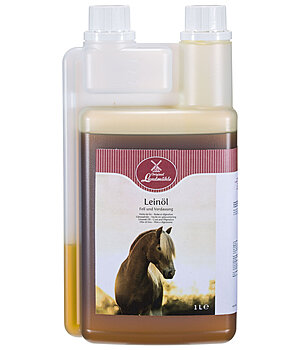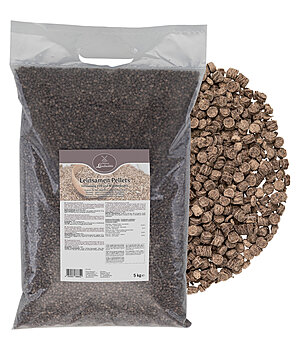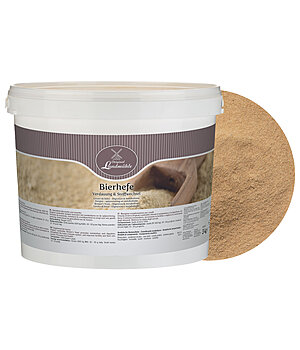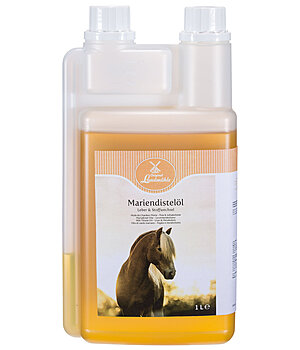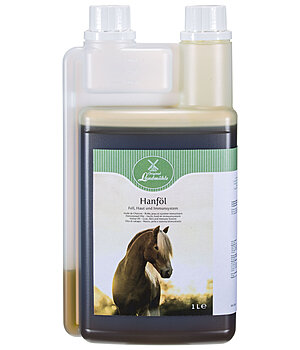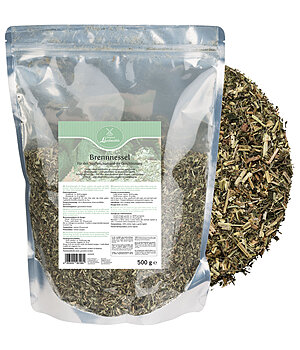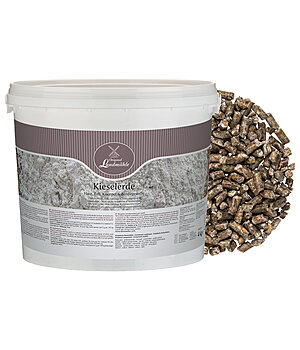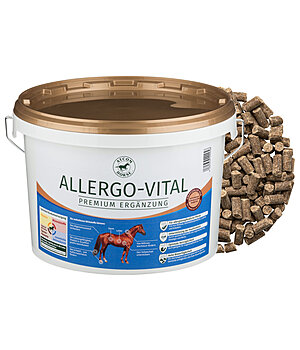What is sweet itch?
Sweet itch is a skin disease in horses that is triggered by an allergic reaction to the saliva of certain insect species – caused by an overreaction of the immune system. While the affected horse still looks completely normal in the winter months, the first symptoms and the outbreak of the disease occur in the warm season. The reason for the seasonal occurrence of the symptoms are the triggering mosquitoes, gnats and black flies, which have their main flight times between March and October. In the following guide, you will find all the information you need on the symptoms, the treatment options and the causes.

Content
What are the typical symptoms of sweet itch?
Typical symptoms of sweet itch are:
- Severe itching
- Skin rash
- Thickening of the skin
- Restlessness and chafing
- Dandruff
- Hair loss
- Open wounds


Particularly affected areas:
Areas of the body with vertically standing hair
- Head
- Crest of the neck
- Croup
- Dock
- Genitalia
- Ventral mid line
The initial symptoms, such as the rash and severe itching, are triggered solely by the sting and the increased immune response to it. The horse wants to get relief by rubbing, but the permanent irritation of the skin leads to secondary symptoms such as open sores, hair loss and dandruff. The open sores in turn attract more and more insects. The immune system struggles with each new sting and triggers symptomatic reactions again and again, creating an endless cycle. The urge to rub oneself and the resulting injuries to the skin also become ever greater.
Without appropriate protective measures and prevention, the horse is defencelessly exposed to insects and sweet itch.
How is sweet itch diagnosed?
In order to diagnose sweet itch, the veterinarian will first get a detailed picture of the horse and the history of the disease. If the symptoms occur exclusively during the insect-rich summer season, it is very likely that the horse is suffering from sweet itch. To rule out the possibility of another allergy or disease, the veterinarian will recommend a test to confirm the diagnosis. This is done via a skin test or a blood test. The skin test is similar to an allergy test at the dermatologist. Various allergens are applied to a clipped area and the skin reactions are observed.
Often, it is not possible to make a reliable diagnosis because of the large number of insect species that cause allergies. A blood test is more reliable. It should be noted, however, that the blood results only represent an allergy susceptibility and are not decisive for whether the sweet itch actually breaks out or runs symptomatically. A reliable diagnosis can only be made by combining the blood test with the actual symptoms.
Can sweet itch be cured? What is the treatment of sweet itch?
First of all, sweet itch is unfortunately incurable, but one can provide relief for the affected horse through preventive measures and proper treatment of the symptoms.

What do I need to consider when caring for the skin?
To relieve the itching and counteract symptoms such as rashes, scaling or even open patches with hair loss, it is essential to rely on regular skin care.
If sweet itch is not (yet) very pronounced, lotions, sprays or oils with natural active ingredients are sufficient.
We explain which active ingredients are often found in eczema care products and what effect they have:
| Disinfecting | Anti-inflammatory | Wound-healing | Insect-repellent | Anti-itching | Nurturing | |
|---|---|---|---|---|---|---|
| Juniper oil |  |  |  | |||
| Tuja oil |  |  |  | |||
| Clove oil |  |  |  |  | ||
| Lavender oil |  |  |  | |||
| Citronella |  |  | ||||
| Birch bark |  |  | ||||
| Urea |  |  | ||||
| Chamomile |  |  | ||||
| Tea tree oil |  |  |  |  | ||
| Coconut oil |  |  |  |  | ||
| Gill oil |  |  | ||||
| Rosemary oil |  |  |  | |||
| Zinc oil |  |  | ||||
| D-Panthenol |  |  |  |  |
If you take preventive measures to avoid sweet itch at an early stage, it is usually sufficient to use skin care products with the above-mentioned active ingredients. In the case of severe sweet itch, the vet must be consulted urgently and may recommend treatment with cortisone or antihistamines.
In addition, you should pay attention to regular coat hygiene. Wash your horse with special sweet itch shampoo regularly in summer. Especially after riding, the insect-attracting sweat should be washed off the horse. On the one hand, it limits the formation of odours so that insects are not so strongly attracted, and on the other hand, the skin care products used for sweet itch sufferers are sometimes very greasy, so that dirt and dust stick to them, which in turn favours the formation of germs and infections.


What should be considered when feeding a horse with sweet itch?
With the wrong diet, you automatically influence the horse’s metabolism, which is already heavily burdened in sweet itch sufferers. Many feed components put a strain on the liver, which plays an important part in the detoxification process of the body. If the liver is overloaded, the metabolism does not function as well, which in turn affects the immune system. Harmful substances that are absorbed by the horse through poor quality or improperly stored feed also damage the immune system in the long run.
Feeding according to the needs of the horse is the basis for preventing sweet itch from spreading and for alleviating the symptoms in the long run.
The following feeding instructions apply in order to protect the metabolism and thus also the immune system:
- Quality: Poor quality favours the development of germs and moulds in the feed.
- Reduce sugar
- Reduce protein
- Omit grains
- No additives
- No silage
In addition, care should be taken to identify deficiency symptoms early enough and to compensate for them. A lack of zinc, copper and selenium is often reflected in the skin’s appearance and thus intensifies the symptoms of sweet itch. But also the supply of vitamins – especially vitamin A and B vitamins – plays an important role in positively influencing the skin’s appearance.
The following ingredients in the feed can have a positive influence on the skin condition of horses with eczema:
- Linseed oil: protein-free, rich in omega-3 and omega-6, anti-inflammatory, strengthens the immune system, supports the skin and ensures a shiny coat.
- Linseed: rich in omega-3 and omega-6, anti-inflammatory, supports the skin and ensures a shiny coat.
- Brewer’s yeast: supports liver and intestinal function and thus strengthens the immune system.
- Zinc: inhibits itching, supports wound healing and metabolism
- Milk thistle oil: protects the liver from toxins, supports the skin through unsaturated fatty acids
- Biotin: supports the formation of keratin, which is contained in the skin and hair.
- Stinging nettle: anti-inflammatory, detoxifying, stimulates metabolism
- Hemp oil: stimulates metabolism, perfect ratio of omega-3 and omega-6 fatty acids, linolenic acid supports skin and coat
- Evening primrose oil: anti-inflammatory, relieves itching & soothes, high content of unsaturated fatty acids, also used in the treatment of skin problems in humans
- Argan oil: promotes regeneration of skin and hair, anti-inflammatory
- Walnut leaves: anti-inflammatory, relieves itching, promotes wound healing
- Magnesium: stimulates skin circulation
- Silica: is important for skin and hair, detoxifying
SELECTED PRODUCTS FOR FEEDING SWEET ITCH SUFFERERS
What are the known causes of sweet itch?
The specific cause of sweet itch is still unclear and controversial among scientists. What is certain is what triggers sweet itch: the overreaction of the immune system is caused by the bite of fertilised female mosquitoes that transmit certain proteins with their spokes, to which a sensitised horse reacts with strong allergic symptoms.
How does sensitisation to this allergen occur?
Researchers have a variety of guesses, which have to be evaluated individually. The causes are therefore different for each eczema sufferer:
| Environmental influences | Pre-existing conditions | Horse Keeping |
|---|---|---|
| Air pollution | Weakened immune system | Poor diet (too much sugar, starch, protein, carbohydrates) |
| Contaminated or polluted feed | Intestinal problems | Stress |
| Climatic conditions | Metabolic disorders | Nutrient supply of the pasture |
| Lack of exercise |
The exact cause of sweet itch is usually difficult to trace. Often, several factors interact or cause a kind of domino effect that results in sweet itch. In order to provide a sweet itch sufferer with the best possible treatment, the first step should therefore be to investigate the causes, starting with the points mentioned above, so that the trigger factors for sweet itch can be limited and the manifestation of the disease can be restricted.
Northern breeds are also repeatedly associated with sweet itch.
Icelandic horses in particular are perceived to belong to the high-risk group. But what is the reason for this?
It is suspected that Icelandic horses have a genetic predisposition – i.e. a hereditary predisposition and susceptibility – to sweet itch. In a study of 490 Icelandic horses, it was found that more than 71% of Icelandic horses imported to the mainland had been affected by sweet itch in their lifetime, while the proportion of Icelandic horses born on the mainland had sweet itch was between 15 and 27%. The older the horses were when imported, the more likely they were to have sweet itch. In Icelandic horses in Iceland, however, sweet itch is extremely rare.

It is therefore obvious that it is not only due to a hereditary component, but that the origin and the related living conditions and environmental influences are also important factors for the outbreak of sweet itch.
One must bear in mind, for example, that there are far fewer mosquitoes in Iceland due to the climatic conditions. In addition, Icelandic horses are adapted to the conditions on the island; the harsh climate, the quality and nutrient situation of the pastures, the exposure to insects and harmful environmental influences and also the amount of exercise are worth mentioning here.
An imported Icelandic horse that comes to the mainland thus first experiences a shock and has to come to terms with the changed living conditions. As the owners in most cases are not able to meet the needs of an Icelandic horse in a „breed-appropriate“ way, health problems and the outbreak of sweet itch often occur.
Independent of the import problem, other breeds such as Haflingers, Fjord horses, Welsh and Shetland ponies are also mentioned in the same breath with sweet itch. Researchers assume, however, that it is not the breeds per se, but rather the way of keeping that causes the accumulation. The number of sweet itch cases has also increased in other breeds since turnout has become more popular. Horses are more likely to be exposed to insects and other environmental influences due to the changed keeping conditions and are not (yet) adapted to them due to their metabolism.
What measures are recommended for prevention?

The basic rule when keeping a horse with sweet itch is: prevention is better than cure! The first thing to do is to protect the horse from insect bites.
This can be done with the help of:
- Sweet itch rugs and other textile accessories for horses with sweet itch, such as sweet itch masks.
- Fly repellents
In addition, the following rules of conduct should be observed when keeping a horse with sweet itch. We explain what these are in the section on keeping a sweet itch horse.
- Prevent the spread of insects in the stable with our tips.
- Offer your horse sufficient retreat possibilities from the insects (e.g. in shed by strip curtains).
- Grazing times should not coincide with the main flight times of the insects.
- Pad popular chafing areas (corners and edges of hayracks, etc.) or remove them if possible.
- Pay attention to your horse’s diet and identify deficiencies early on.
- If in doubt, always consult your veterinarian and get extensive advice from him or her




